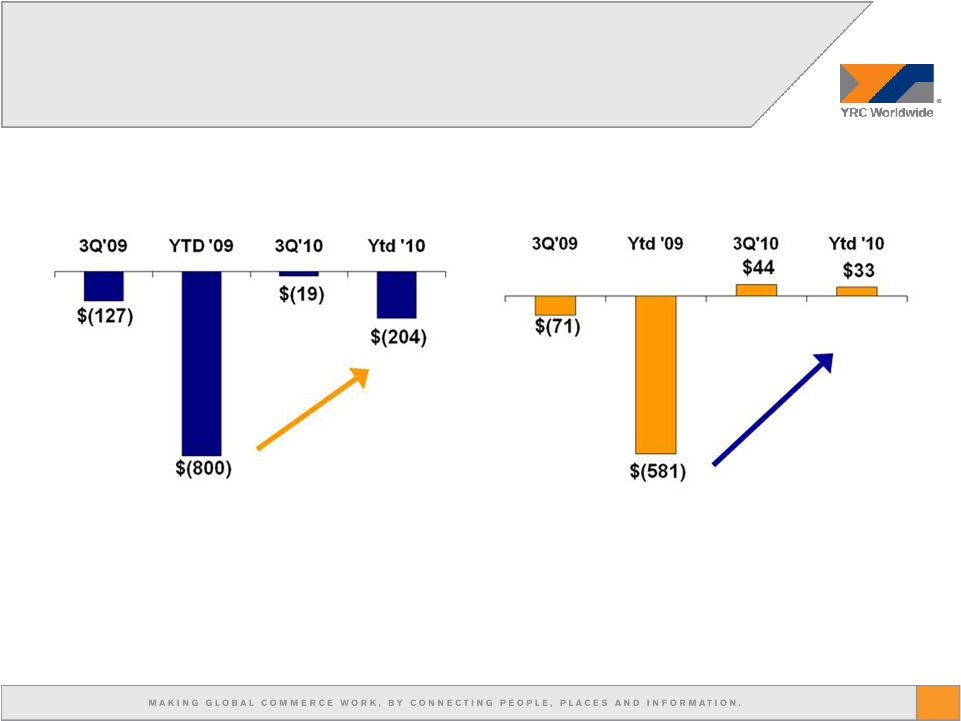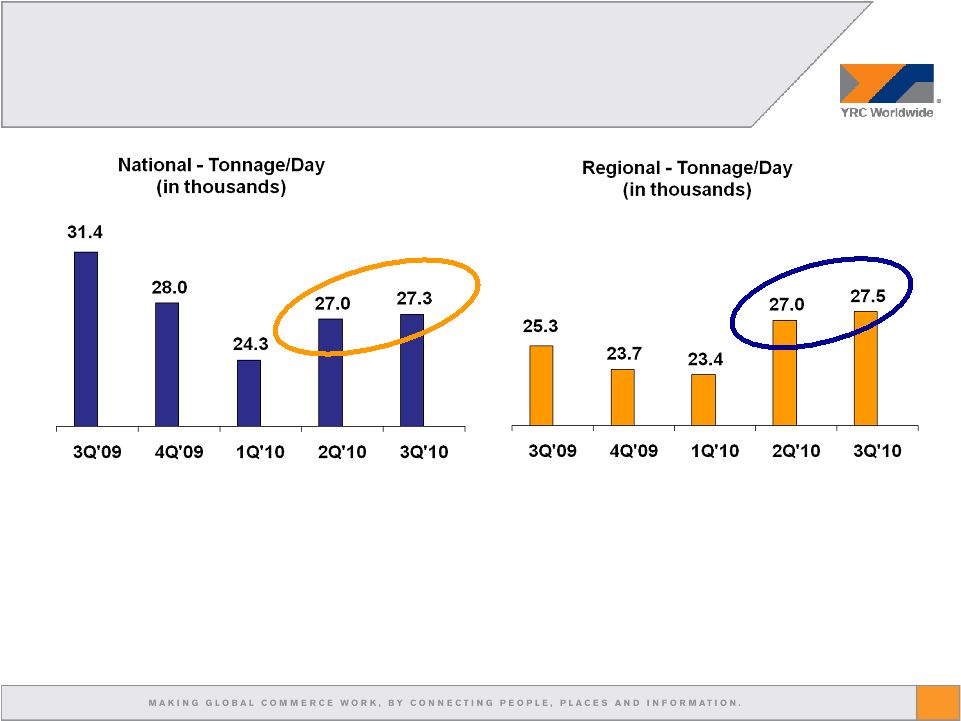Attached files
| file | filename |
|---|---|
| EX-99.2 - MEMORANDUM IN SUPPORT OF MOTION TO DISMISS - Yellow Corp | dex992.htm |
| 8-K - FORM 8-K - Yellow Corp | d8k.htm |
 Investor
Presentation November 2010
Exhibit 99.1 |
 2
Overview
Overview
•
Opening Comments
•
Strategy
•
Stakeholder Support
•
New Labor Contract
•
Operating Improvements and Key Milestones
•
Liquidity
•
Summary |
 3
Business Segments
Business Segments
•
The company’s National and Regional networks provide the most comprehensive North
American network and flexible solutions to meet its customers’
diverse transportation needs
•
Sale of YRC Logistics allows YRCW to focus on its core businesses
•
Customers maintain access to logistics services via commercial services agreement
Transportation & Logistics
Transportation & Logistics
North American LTL & TL
North American LTL & TL
U.S. National LTL
Inter/Intra-Canada LTL
Truckload
Regional LTL
Regional LTL
Global Logistics
Global Logistics
Western U.S. & Canada
Central U.S. & Canada
Northeast U.S. & Canada
China Ground, Global Forwarding
Jiayu
Jing Jiang
73%
$1.3 Billion 27%
YRC Worldwide Inc. 2009 Revenue: $4.9 Billion
(1)
(1)
Adjusted to exclude $.4 billion revenue from YRC Logistics segment reported as
discontinued operations effective 2Q 2010. $3.6 Billion
$40 million / $265 million |
 4
National and Regional Networks
National and Regional Networks
4
Strategy:
Achieve competitive cost base and enhanced customer mix
management, resulting in improved earnings and cash flows |
 Stakeholder Support
Stakeholder Support
5
•
Stakeholders alignment to ensure
future success
•
Liquidity programs
•
Sale of assets
•
Deferral of pension contributions
•
Lender flexibility
•
Addressed 2010 bond obligations
•
Converted $470 million of bonds to
equity
•
Refinanced remaining bonds with
$70 million of new 6% notes
•
Competitive cost base
•
Customer confidence |
 6
Labor Contract Overview
Labor Contract Overview
•
Extended by two years from 2013 to March 31, 2015
•
Re-entry of YRCW companies into multi-employer pension plans in
June 2011, at a more affordable level of contribution
•
Sustains the current competitive cost structure and improves future
operating leverage, as work rule
changes drive cost efficiencies to
more than offset returning pension contributions and to promote
service enhancements
•
Addresses the long-term market competitiveness of YRCW, which is
designed to protect jobs, enable long-term growth and generate
financial returns to its stakeholders
•
ABF lawsuit update |
 7
Key Financial Recovery Milestones…to Date
Key Financial Recovery Milestones…to Date
•
2Q and 3Q 2009 –
sequential improvement in adjusted EBITDA
•
4Q 2009 –
sequential and year-over-year improvement in
adjusted EBITDA
•
March 2010 –
volume growth returns
•
April 2010 –
breakeven adjusted EBITDA
•
2Q 2010 –
positive adjusted EBITDA quarter, first since 3Q 2008
•
3Q 2010:
•
Second consecutive quarter of positive adjusted EBITDA
•
Positive cash flow from operating activities
•
Regional operating ratio 97.6
•
National operating ratio 102.9
•
YRCW operating ratio improved 8.8 year-over-year |
 Year-Over-Year Operating Improvement
Year-Over-Year Operating Improvement
•
Cost actions, price discipline, and customer mix management
•
Expect YRCW to be adjusted EBITDA positive in 4Q 2010
Adjusted EBITDA is a non-GAAP measure that reflects the company’s earnings
before interest, taxes, depreciation, and amortization expense, and further
adjusted for letter of credit fees, professional restructure fees, discontinued
operations, and other items as defined in the company’s Credit Agreement. Adjusted
EBITDA is used for internal management purposes as a financial measure that reflect
the company’s core operating performance and is used by management to
measure compliance with financial covenants in the company’s Credit Agreement. This financial measure should not be construed as a better measurement
than operating income as defined by generally accepted accounting principles. See
Pages15 and16 for reconciliations of GAAP measures to non-GAAP financial
measures. 8
Operating Loss
(in millions)
Adjusted EBITDA
(in millions) |
 Tonnage Per Day Trends
•
Sequential volume improvement trends
•
National up 1.2% from 2Q 2010; second consecutive sequential increase
•
Regional up 2.1% from 2Q 2010; year-over-year up 9%
•
Market share stabilized during 2Q & 3Q; now positioned for future profitable
growth 9 |
 10
Liquidity
Liquidity
•
Stable liquidity position
•
Proactive actions to fund working capital for revenue growth
•
DSO improvement 3 days year-over-year
•
Renewal of $325 million asset-backed securitization through October 2011
Note: Revolver reserves are subject to the terms of the company’s
credit agreement with its lenders. |
 11
Summary
Summary
•
Strategic focus on core business
•
Improving operational performance
•
Stakeholder alignment
•
Customer confidence |
 12
Appendix |
 2010
Expectations 2010 Expectations
•
YRCW positive adjusted EBITDA and be well within credit
agreement financial covenants in 4Q 2010
•
Gross capital expenditures of $20 to $30 million
•
Excess property sales of $70 to $80 million
•
Sale and financing leasebacks approximately $50 million
•
Effective income tax rate of 3%
13 |
 Common
Share Recap Pre-Split and Post-Split Common Share Recap Pre-Split and
Post-Split 14
Authorized
Outstanding
(1)
6% Notes
(2)
Options/RSU’s
(3)
Available
Jun 30
2 billion
1.124 billion
202 million/
$70M
350 million
324 million
Post 1:25 Split
Jun 30
(pro forma)
80 million
45 million
8 million
14 million
13 million
Sep 30
80 million
47.5 million
5.5 million/
$69.410M
14 million
13 million
1)
Per third quarter 2010 10-Q
2)
Pro
forma
amounts,
assuming
$70m
notes
are
fully
converted
into
shares,
inclusive
of
interest
and
make-whole
amounts
paid
in
shares;
represents
an
‘all-in’
conversion
rate
of
approximately $8.67/share ($0.35/share pre-split)
a)
In August 2010, the company temporarily modified the conversion ratio to $0.25/share
($0.01/share pre-split) and issued 2.4m shares (59m pre-split) in conversion of
$590,000 of notes. In addition, the company issued 0.2 m shares (5.5m pre-split)
for semi-annual interest due August 15, 2010. b)
Remaining
5.5m
shares
relate
to
outstanding
notes
of
$69.41m
or
an
‘all-in’
conversion
ratio
of
approximately
$12.61
per
share
for
future
conversions
(approximately
$.50/share pre-split).
3)
Includes June 2010 Teamster option awards of 10.5m (264m pre-split) with a strike
price of $12/share ($0.48/share pre-split), June 2010 shareholder approval of 2.7m shares (67m
pre-split) for the non-union equity plan which are available for future equity
awards and 2009 employee awards (union and non-union) of 0.6m (15m pre-split). |
 Consolidated Adjusted EBITDA
Consolidated Adjusted EBITDA
15
For the Three and Nine Months Ended September 30
2010
2009
2010
2009
Operating revenue
1,136,836
$
1,203,977
$
3,243,081
$
3,820,916
$
Operating Ratio, as adjusted
101.7%
110.5%
105.5%
120.4%
Reconciliation of operating loss to adjusted EBITDA:
Operating loss
(18,836)
$
(126,648)
$
(203,726)
$
(799,556)
$
Union equity awards
-
-
24,995
20,639
Operating loss, as adjusted
(18,836)
(126,648)
(178,731)
(778,917)
(Gains) losses on property disposals, net
(3,429)
(11,138)
3,183
(10,579)
Impairment charges
-
-
5,281
-
Depreciation and amortization
49,785
58,346
150,491
181,173
Equity based compensation expense
2,211
2,032
5,545
8,147
Letter of credit expense
8,321
8,838
24,943
23,301
Restructuring professional fees
6,594
n/a
15,936
n/a
Reimer Finance Co. dissolution (foreign exchange)
n/a
n/a
5,540
n/a
Other nonoperating, net
(312)
(2,018)
1,029
(4,495)
Adjusted EBITDA
44,334
$
(70,588)
$
33,217
$
(581,370)
$
Operating Ratio, as adjusted is calculated as 100 minus the result of dividing operating income,
as adjusted by operating revenue or plus the result of dividing operating loss, as adjusted by
operating revenue, and expressed as a percentage. Three Months
Nine Months
SUPPLEMENTAL FINANCIAL INFORMATION
YRC Worldwide Inc. and Subsidiaries
(Amounts in thousands)
(Unaudited) |
 2010
Consolidated Operating Cash Flows 2010 Consolidated Operating Cash Flows
16
YRC Worldwide Inc. and Subsidiaries
(Amounts in thousands)
(Unaudited)
1Q 2010
2Q 2010
3Q 2010
Reconciliation of Adjusted EBITDA to net cash
from (used in) operating activities:
Adjusted EBITDA
(51,034)
$
39,917
$
44,334
$
Add back amounts included in Adjusted EBITDA:
Restructuring professional fees
n/a
(9,342)
(6,594)
Discontinued operations and permitted dispositions
(2,135)
(7,421)
1,347
Cash interest
(10,876)
(10,062)
(11,009)
Working capital cash flows, net
1,063
(47,870)
(22,678)
Net cash used in operating activities before income taxes
(62,982)
(34,778)
5,400
Cash income tax refunds, net
81,272
2,016
(253)
Net cash (used in) provided by operating activities
18,290
$
(32,762)
$
5,147
$ |
 17
Forward-Looking Statements
Forward-Looking Statements
This
presentation
contains
forward-looking
statements
within
the
meaning
of
Section
27A
of
the
Securities
Act
of
1933,
as
amended,
and
Section
21E
of
the
Securities
Exchange
Act
of
1934,
as
amended.
The
words
“believe,”
“expect,”
“continue,”
and
similar
expressions
are
intended
to
identify
forward-looking
statements.
It
is
important
to
note
that
the
company’s
actual
future
results
could
differ
materially
from
those
projected
in
such
forward-looking
statements
because
of
a
number
of
factors,
including
(among
others)
our
ability
to
generate
sufficient
cash
flows
and
liquidity
to
fund
operations,
which
raises
substantial
doubt
about
our
ability
to
continue
as
a
going
concern,
inflation,
inclement
weather,
price
and
availability
of
fuel,
sudden
changes
in
the
cost
of
fuel
or
the
index
upon
which
the
company
bases
its
fuel
surcharge,
competitor
pricing
activity,
expense
volatility,
including
(without
limitation)
expense
volatility
due
to
changes
in
rail
service
or
pricing
for
rail
service,
ability
to
capture
cost
reductions,
changes
in
equity
and
debt
markets,
a
downturn
in
general
or
regional
economic
activity,
effects
of
a
terrorist
attack,
labor
relations,
including
(without
limitation)
the
impact
of
work
rules,
work
stoppages,
strikes
or
other
disruptions,
any
obligations
to
multi-employer
health,
welfare
and
pension
plans,
wage
requirements
and
employee
satisfaction,
and
the
risk
factors
that
are
from
time
to
time
included
in
the
company’s
reports
filed
with
the
SEC.
The
company’s
expectations
regarding
the
rate
and
timing
of
pricing
and
revenue
mix
improvements
are
only
its
expectations
regarding
these
matters.
Actual
rate
and
timing
of
pricing
and
revenue
mix
improvements
could
differ
based
on
a
number
of
factors
including
(among
others)
general
economic
trends
and
excess
capacity
within
the
industry,
and
the
factors
that
affect
revenue
results
(including
the
risk
factors
that
are
from
time
to
time
included
in
the
company’s
reports
filed
with
the
SEC).
The
company’s
expectations
regarding
the
timing
and
degree
of
market
share
growth
are
only
its
expectations
regarding
these
matters.
Actual
timing
and
degree
of
market
share
growth
could
differ
based
on
a
number
of
factors
including
(among
others)
the
company’s
ability
to
persuade
existing
customers
to
increase
shipments
with
the
company
and
to
attract
new
customers,
and
the
factors
that
affect
revenue
results
(including
the
risk
factors
that
are
from
time
to
time
included
in
the
company’s
reports
filed
with
the
SEC).
The
company’s
expectations
regarding
the
impact
of,
and
the
service
and
operational
improvements
and
collateral
and
cost
reductions
due
to,
the
integration
of
Yellow
Transportation
and
Roadway,
improved
safety
performance,
right-sizing
the
network,
consolidation
of
support
functions,
the
company’s
credit
ratings
and
the
timing
of
achieving
the
improvements
and
cost
reductions
could
differ
materially
from
actual
improvements
and
cost
reductions
based
on
a
number
of
factors,
including
(among
others)
the
factors
identified
in
the
preceding
and
following
paragraphs,
the
ability
to
identify
and
implement
cost
reductions
in
the
time
frame
needed
to
achieve
these
expectations,
the
success
of
the
company’s
operating
plans
and
programs,
the
company’s
ability
to
successfully
reduce
collateral
requirements
for
its
insurance
programs,
which
in
turn
is
dependent
upon
the
company’s
safety
performance,
ability
to
reduce
the
cost
of
claims
through
claims
management,
the
company’s
credit
ratings
and
the
requirements
of
state
workers’
compensation
agencies
and
insurers
for
collateral
for
self-
insured
portions
of
workers’
compensation
programs,
the
need
to
spend
additional
capital
to
implement
cost
reduction
opportunities,
including
(without |
 Forward-Looking Statements
Forward-Looking Statements
18
limitation)
to
terminate,
amend
or
renegotiate
prior
contractual
commitments,
the
accuracy
of
the
company’s
estimates
of
its
spending
requirements,
changes
in
the
company’s
strategic
direction,
the
need
to
replace
any
unanticipated
losses
in
capital
assets,
approval
of
the
affected
unionized
employees
of
changes
needed
to
complete
the
integration
under
the
company’s
union
agreements,
the
readiness
of
employees
to
utilize
new
combined
processes,
the
effectiveness
of
deploying
existing
technology
necessary
to
facilitate
the
combination
of
processes,
the
ability
of
the
company
to
receive
expected
price
for
its
services
from
the
combined
network
and
customer
acceptance
of
those
services.
The
company's
expectations
regarding
the
lawsuit
filed
by
ABF
are
only
its
expectations
regarding
this
matter.
The
actual
outcome
of
ABF
lawsuit
is
dependent
on
final
resolution
of
the
claims
through
the
courts
or
grievance
process
under
the
company's
labor
agreement.
The
company's
expectations
regarding
the
amount
and
timing
of
receipt
of
a
working
capital
adjustment
in
connection
with
the
sale
of
a
majority
of
its
Logistics
business
are
only
its
expectations
regarding
these
matters.
The
actual
amount
and
timing
of
receipt
of
a
working
capital
adjustment
is
dependent
on
final
resolution
of
the
amount
with
the
buyer
of
the
Logistics
business
in
accordance
with
the
related
purchase
agreement.
The
company’s
expectations
regarding
re-entry
into
multi-employer
pension
funds
to
which
it
contributes
are
only
its
expectations
regarding
this
matter.
Whether
multi-employer
pension
funds
to
which
the
company
contributes
approve
the
company’s
re-entry
into
the
funds
and
the
timing
and
terms
and
conditions
of
any
re-entry
is
dependent
upon
approval
by
the
affected
funds.
Actual
contributions
to
multi-employer
pension
funds
are
also
affected
by
levels
of
employment.
The
company’s
expectations
regarding
the
benefits
from
the
new
labor
contract
are
only
its
expectations
regarding
this
matter.
The
wage,
benefit
and
work
rule
concessions
in
the
new
labor
contract
may
cease
if
a
committee
representing
the
Teamsters
(“TNFINC”)
exercises
its
rights
in
the
new
labor
contract
described
below.
•
TNFINC
was
given
the
right
to
approve
certain
changes
of
control
applicable
to
the
company.
If
TNFINC
approval
is
not
received,
TNFINC
may
declare
the
wage,
benefit
and
work
rule
concessions
null
and
void
on
a
prospective
basis.
•
In
the
event
of
a
bankruptcy
of
the
company,
TNFINC
may
declare
the
wage,
benefit
and
work
rule
concessions
null
and
void. |
 Forward-Looking Statements
Forward-Looking Statements
19
•
The
company
expects
to
begin
discussions
to
restructure
the
debt
under
its
credit
agreement,
which
may
include
additional
capital
investment
(debt
and/or
equity)
by
third
parties
in
a
recapitalization.
The
new
labor
contract
provides
the
following:
o
TNFINC
would
have
the
right
to
approve
the
various
transactions
comprising
the
restructuring/recapitalization.
o
If
TNFINC’s
approval
is
not
obtained,
TNFINC
may
declare
the
wage,
benefit
and
work
rule
concessions
null
and
void
on
a
prospective
basis,
and
the
company
would
owe
its
Teamster
employees
an
amount
equal
to
the
concessions
that
in
fact
benefited
the
company
prior
to
the
termination.
o
TNFINC
would
have
significant
rights
to
participate
in
the
restructuring/recapitalization
discussions.
o
In
deciding
whether
to
give
its
approval
to
a
restructuring/recapitalization,
TNFINC
could
demand
on
behalf
of
Teamster
represented
employees
of
the
company’s
subsidiaries
additional
compensation
if
negotiated
performance
triggers
are
met,
equity
participation,
specified
terms
in
the
restructuring,
specified
indebtedness
levels
resulting
from
the
transactions,
governance
rights
and
financial
viability
criteria.
o
The
company
is
required
to
enter
into
definitive
agreements
to
effect
the
restructuring/recapitalization
by
December
31,
2010
and
close
those
transactions
by
March
31,
2011,
or
in
each
case,
such
later
date
as
TNFINC
would
agree
and,
in
each
case,
on
terms
and
conditions
that
TNFINC
approves.
The
company’s
expectations
regarding
ratification
of
a
new
labor
agreement
for
Reddaway
and
the
timing
of
any
ratification
are
only
its
expectations
regarding
this
matter.
Ratification
of
a
new
labor
agreement
for
Reddaway
is
dependent
on
a
majority
of
Reddaway's
union
employees
who
are
eligible
to
vote
to
approve
the
new
labor
agreement.
The
company’s
expectations
regarding
its
ability
to
replace
the
ABS
with
a
new
facility
are
only
its
expectations
regarding
this
matter.
Whether
the
company
is
able
to
replace
the
ABS
and
the
terms
of
any
replacement
facility
are
dependent
upon
a
number
of
factors
including
(among
others)
the
company
reaching
agreement
with
interested
lenders
and
closing
such
transaction
on
negotiated
terms
and
conditions.
The
company’s
expectations
regarding
multi-employer
pension
plan
reform
are
only
its
expectations
regarding
this
matter.
The
impact
to
the
company
and
the
multi-employer
pension
plans
to
which
it
contributes
of
such
reform
is
subject
to
a
number
of
conditions,
including
(among
others)
whether
Congress
passes
legislation
to
reform
multi-employer
pension
plans
and
the
timing
of,
and
provisions
included
in,
such
legislation. |
 Forward-Looking Statements
Forward-Looking Statements
20
The
company’s
expectations
regarding
the
continued
support
of
its
stakeholders
are
only
its
expectations
regarding
this
matter.
Whether
the
company’s
stakeholders
continue
to
support
the
company
including
(among
other
things)
to
continue
deferral
arrangements
in
2011
or
to
restructure
obligations
owed
to
such
stakeholders
is
subject
to
a
number
of
conditions
including
(among
other
things)
the
outcome
of
discussions
with
such
stakeholders,
whether
requested
support
meets
their
requirements
and
the
factors
identified
in
the
preceding
paragraphs.
The
company’s
expectations
regarding
future
asset
dispositions
and
sale
and
financing
leasebacks
of
real
estate
are
only
its
expectations
regarding
these
matters.
Actual
dispositions
and
sale
and
financing
leasebacks
will
be
determined
by
the
availability
of
capital
and
willing
buyers
and
counterparties
in
the
market
and
the
outcome
of
discussions
to
enter
into
and
close
any
such
transactions
on
negotiated
terms
and
conditions,
including
(without
limitation)
usual
and
ordinary
closing
conditions
such
as
favorable
title
reports
or
opinions
and
favorable
environmental
assessments
of
specific
properties.
The
company’s
expectations
regarding
liquidity,
working
capital
and
cash
flow
are
only
its
expectations
regarding
these
matters.
Actual
liquidity,
working
capital
and
cash
flow
will
depend
upon
(among
other
things)
the
company’s
operating
results,
the
timing
of
its
receipts
and
disbursements,
the
company’s
access
to
credit
facilities
or
credit
markets,
the
company’s
ability
to
continue
to
defer
interest
and
fees
under
the
company’s
credit
agreement
and
ABS
facility
and
interest
and
principal
under
the
company’s
contribution
deferral
agreement,
the
continuation
of
the
wage,
benefit
and
work
rule
concessions
under
the
company's
modified
labor
agreement
and
temporary
cessation
of
pension
contributions,
and
the
factors
identified
in
the
preceding
paragraphs.
The
company’s
expectations
regarding
its
capital
expenditures
are
only
its
expectations
regarding
this
matter.
Actual
expenditures
could
differ
materially
based
on
a
number
of
factors,
including
(among
others)
the
factors
identified
in
the
preceding
paragraphs.
The
company’s
expectations
regarding
its
compliance
with
its
credit
agreement
covenants
are
only
its
expectations
regarding
these
matters.
Whether
the
company
satisfies
the
covenants
under
its
credit
agreement
is
subject
to
a
number
of
factors,
including
(among
others)
the
factors
identified
in
the
preceding
paragraphs.
The
company’s
expectations
regarding
its
effective
tax
rate
are
only
its
expectations
regarding
this
rate.
The
actual
rate
could
differ
materially
based
on
a
number
of
factors,
including
(among
others)
variances
in
pre-tax
earnings
on
both
a
consolidated
and
business
unit
basis,
variance
in
pre-tax
earnings
by
jurisdiction,
impacts
on
our
business
from
the
factors
described
above,
variances
in
estimates
on
non-deductible
expenses,
tax
authority
audit
adjustments,
change
in
tax
rates
and
availability
of
tax
credits.
The
company’s
expectations
regarding
its
ability
to
complete
its
comprehensive
recovery
plan
are
only
its
expectations
regarding
these
matters.
Whether
the
company
is
able
to
complete
its
comprehensive
recovery
plan
is
dependent
upon
a
number
of
factors
including
(among
others)
the
company
reaching
agreement
with
its
stakeholders
and
interested
investors
and
closing
transactions
on
negotiated
terms
and
conditions,
including
(without
limitation)
any
closing
conditions
that
the
company’s
stakeholders
and
investors
may
require. |
